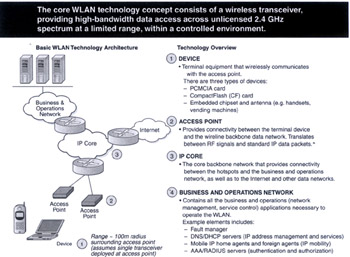Chapter 5: Interference and Quality of Service (QoS) on 802.11 Networks
|
|
Overview
If 802.11 networks are to be a viable bypass of the Public Switched Telephone Network (PSTN), they must deliver a subscriber experience comparable to that of the PSTN. This is especially important in regards to voice services. Incumbent telcos take great pride in delivering good voice quality on their legacy networks with relatively reliable service. When it comes to replacing the copper wires or fiber cables of the PSTN with the airwaves of 802.11, many people are concerned that the airwaves, since they are not as controllable or predictable as copper wire or fiber cables, will deliver an inferior quality of service (QoS) or may be susceptible to interference from other emitters in the electromagnetic spectrum. What will entice consumers, both business and residential, to give up the tried and true PSTN service for wireless service? The answer is greater bandwidth (11 Mbps versus 56 Kbps) that delivers data services including video streaming, video on demand, videoconferencing, music file sharing, and local and long-distance telephone service for a monthly service fee that is marginally more than that of a combined monthly phone, cable TV, and Internet access bill.
Perhaps the main objection to wireless data services is the mis-perception that the signal will severely suffer from interference from sources that are external to the network. These sources are reputed to be garage door openers, microwave ovens, cordless phones, and so on. A further concern is that the subscriber must have a direct line of sight from the service provider's transmitter. These concerns segue into concerns about the QoS of 802.11 networks. The transmission of a packetized medium (Internet Protocol [IP]) over wires has its own series of challenges in addition to interference. This chapter addresses concerns over interference, line of sight, and QoS improvements made possible by 802.11e. There are no problems in telecommunications, only solutions.
As illustrated in Figure 5-1, QoS has to be measured across the total network, encompassing both the wired and wireless portions of the network. It does no good to have a very high-quality service level agreement (SLA) for IP services via a wired network if your wireless connection to the access point (AP) via a wireless connection suffers from interference or severe latency, and vice versa. Latency is measured from endpoint to endpoint across a network.

Figure 5-1: QoS is measured from endpoint to endpoint, encompassing both the wired and wireless portions of the network.
|
|
EAN: 2147483647
Pages: 96